Another SaaS Newsletter?Yep. But This One’s Actually Worth Reading. 🕶
Get mobile commerce insights, tips on improving ROAS, product updates, and the occasional hot take—minus the fluff.
Curated by a team that’s been in Shopify since the early days.
Instantly build beautiful, high-converting commerce apps and engage your customers with push notifications. Fully extensible with custom code.
Just what you need to scale smarter.
Blogs You Might Like
.png)
Push notifications vs SMS: How to pair them to max mobile engagement
Ever wonder how much time we actually spend scrolling every day? Well, the results are in: the average consumer spends over five hours a day on their phones. For those who get a weekly screen time recap, this number isn’t surprising.
But it also shows why mobile marketing is more important than ever.
Mobile commerce accounted for 7.4% of total U.S. retail sales in 2024. The small screen drives a massive share of ecommerce growth.
The tricky part is, it’s also a massively crowded field. The average smartphone user in the U.S. receives about 46 push notifications every day. That’s not even counting all the text messages, calls and emails. People are accustomed to filtering things out.
So, how do you cut through all the digital clutter?
That’s where short message service (SMS) marketing and push notifications can help: aka, the ultimate power couple. Like crafting the perfect peanut butter and jam sandwich, only brands that can master the delicate balance between SMS and push notifications will be able to rise above the noise.
And with new privacy changes reshaping how SMS is delivered, pairing these two strategies has never been more crucial.
Read ahead to learn more about:
- What SMS marketing and push notifications are
- Why they work
- When and how to use them
- How to build a winning SMS and push notification strategy
- How to create app-free push notifications with Reactiv Clips
What is SMS marketing?
SMS marketing lets ecommerce brands send promotional or informational texts to the phones of customers who opt in.
For years, SMS marketing has been the go-to strategy for reaching customers and (almost) guaranteeing that they’ll see your message—and for a good reason. The average open rate for SMS messages is 95%.
But why do customers actually opt to receive SMS messages? Well, sometimes they want to stay up-to-date on the latest offers. Other times, stores have incentivized SMS opt-ins with welcome discounts.
Whatever the reason, customers are clearly very willing to trade their phone numbers for the perceived value of SMS marketing. In 2025, 84% of customers opted in to SMS messages.
Why it works
The biggest benefits of SMS marketing can be summed up in five categories:
- Reach: You can reach users on all mobile phones with no internet connection or app required.
- Speed: Most of your messages will be read immediately because customers are already primed to read incoming messages—32% of customers read new text messages within 1 minute. A further 50% read them within 5 minutes.
- Trust: SMS is a familiar channel that’s part of most customers’ everyday lives. They also directly opted in to receive them.
- Return on investment (ROI): SMS marketing is a cost-effective strategy with high engagement rates. It typically delivers $21–$41 ROI for every $1 spent.
- Conversion: 72% of consumers have purchased after receiving an SMS from a brand.
When to use it
SMS marketing can be a huge boost to any multi-channel retargeting strategy. It’s great for personalized messages, like these:
- Welcome offers for new subscribers: “Welcome to the club! Enjoy 15% off your first purchase with code WELCOME15”
- Urgent promotions: “Flash sale ends in 2 hours”
- Subscription renewals or timely restock notifications: “Running low? It’s time to restock on [product]”
- Abandoned-cart recovery with discounts: “Leave something behind? Take 10% off your cart”
- Transactional alerts: “Your order has shipped/been delivered”
Example with Mejuri
Mejuri, a fine jewellery company, offers new SMS subscribers 10% off their next purchase with a custom discount code.
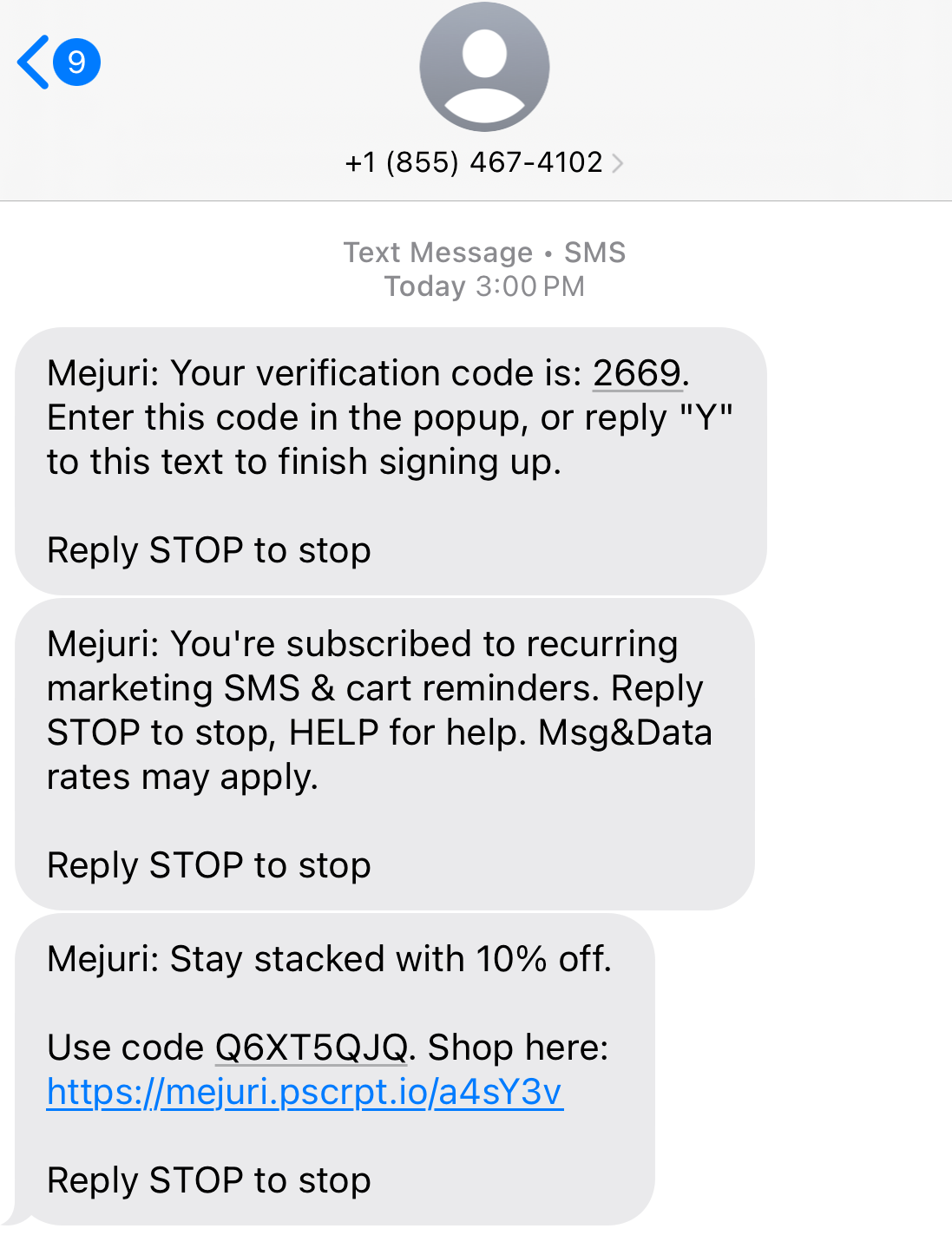
What are push notifications?
Push notification marketing is a personalized type of communication where brands send timely, direct messages to users. This is usually through desktops, mobile devices or in-app notifications. They’re often used as part of a retargeting strategy, but they’re also great for stand-alone campaigns.
While they don’t need a user’s phone number or email address, they usually are sent to shoppers who have your mobile app downloaded.
But now with Reactiv Clips, there’s no app download needed, either.
How does it work? Brands can send timely push notifications to customers who clicked on their ads without needing an app install or an opt-in. And the results speak for themselves.
Reactiv users see an average 60% open rate on personalized pushes and a 5–7% conversion rate.
Why they work
Here are the six biggest benefits of using push notifications:
- Increased ownership: Helps you avoid carrier restrictions, delivery issues or message filtering with your owned app or website.
- Stronger personalization: Guides your user directly from notification to app checkout in one click. Use best practices like behavioral triggers, segmentation, and seamless post-click journeys to do this.
- Cost-effective: Once you have an app up and running, push notifications are free to send. This is a great way to avoid any additional per-message fees.
- More rich content: Allows you to stand out on your user’s homescreen in an on-brand way that’s uniquely yours. Make the experience interactive with visual elements like emojis, GIFs and deep links.
- Increased retention and engagement: Apps with push enabled see 88% better engagement and 65% higher retention in the first 30 days than those that don’t.
- Revenue lift: Personalized push notifications generate up to 10x more revenue per user than email/SMS.
When to use them
Push notifications are best used for re-engagement, lifecycle marketing and driving repeat visits. They work especially well when the message is personalized, timely and action-oriented. They also have a clear call-to-action (CTA).
Try push notifications for:
- Personalized product recommendations: “Your favourites are back in stock. Check them out!”
- Post-purchase follow-ups: “Rate your recent order to earn points”
- Abandoned-cart reminders: “You left something behind! Checkout now for 10% off”
- Browse abandonment campaigns: “See something you like? Hurry–they’re going quickly!”
- Loyalty milestones or VIP rewards: “You’ve reached Gold Status! Use GOLD15 for a discount on your next order”
- Reactivation campaigns: “We miss you! Here’s 15% off your next order”
Remember: for the highest engagement and conversion lift, use context-driven messages based on behaviour triggers, like browsing a certain product or adding something to cart.
Example with Top of the Mornin’
Top of the Mornin’ Coffee takes a cozy, creative approach to push notification marketing. They use them to build community and loyalty. Rather than conversion-based copy, the brand sends reminders to “Have a great day!” or “Enjoy a cup of coffee” (aww) in order to stay top of mind.
And it’s working—they’re seeing higher brand affinity and repeat engagement from app users. How sweet is that?
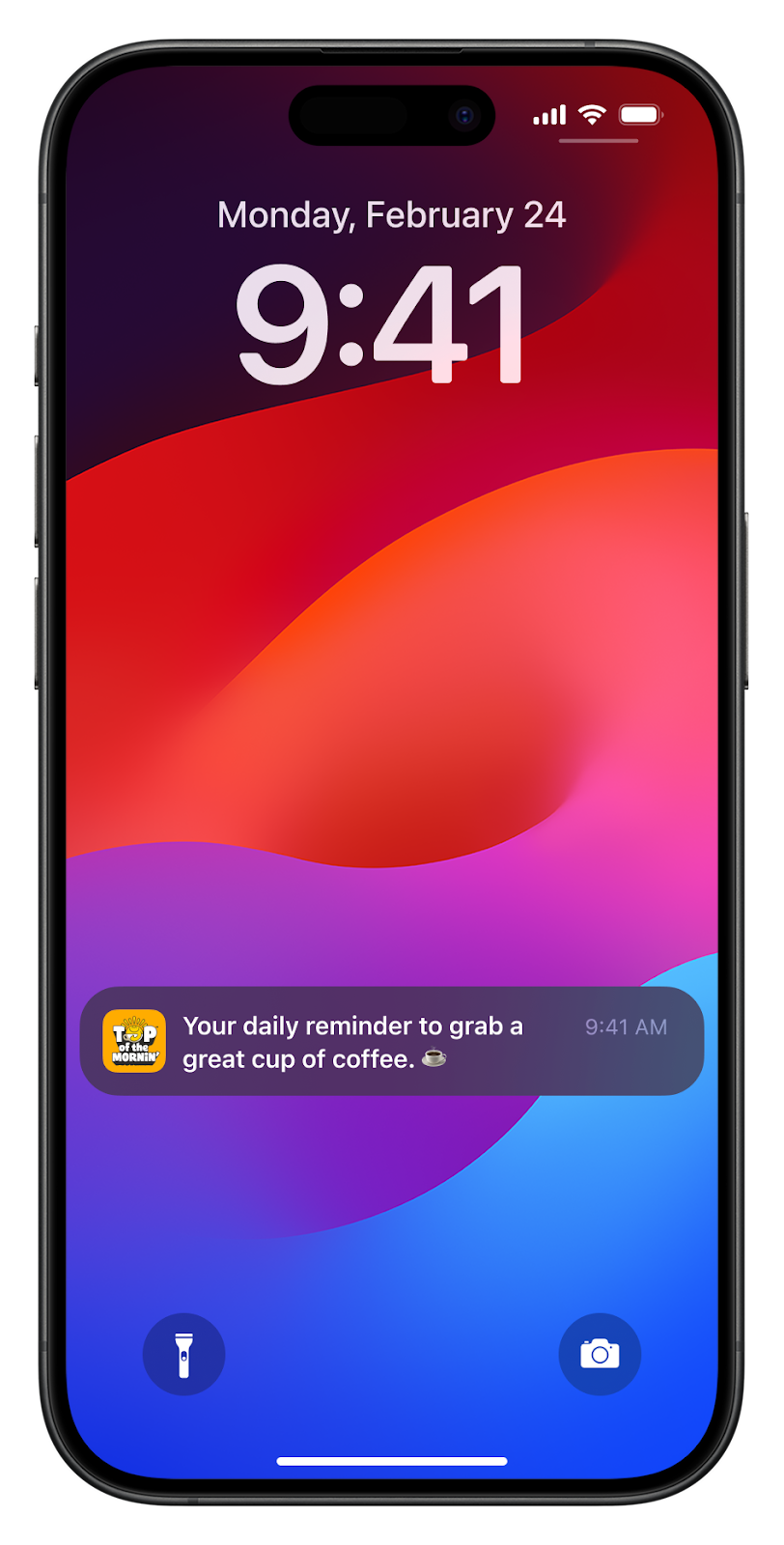
SMS vs. push notifications—what’s the difference?
They may both pop up on your phone screen, but push notifications and SMS messages are not the same.
In a nutshell:
- SMS marketing is great for ensuring your customer sees and opens your message immediately.
- Push notifications are best for driving engagement and retention with hyper-personalized behaviour-triggers.
Here’s a breakdown of other important differences:
| SMS | Push notifications | |
|---|---|---|
| Delivery and access | Sent via carrier network to a user’s phone | Delivered through app/web platform (unless you’re using Reactiv Clips, which make app-free push notifications possible) |
| Message format and length | Simple, text-based, up to 160 characters | Under 10 words, can include visuals, CTAs, emojis or deep links |
| Opt in and control | Users share phone number, opt out unsubscribes them completely | Users choose what type of notifications to receive through app/browser permission (or Reactiv Clips). This flexibility can lead to lower unsubscribe rates and higher long-term engagement. |
| Level of personalization | Basic segments, ideal for direct, one-to-one communication like transactional updates or short-term promotions | Deep, behavior-driven. Excel at hyper-personalized, context-driven messages based on real-time behavior. |
| Filtering risk | Rising with “Unknown Sender” filters | Minimal once opted in |
| Privacy and deliverability | More regulated, new filters like Apple’s iOS 26 “Unknown Senders” feature moving marketing texts into a quiet side folder | Operates within your owned system, reducing dependency on external networks and improving deliverability |
| Cost | Brands pay per message | Free once users opt in |
| Ownership | Third-party carriers | Brand-owned |
How iOS 26 is changing the SMS playbook
With Apple’s recent iOS 26 rollout, the new “Unknown Senders” filtering can push any text from a number you haven’t saved into a quiet side folder. This applies even if you’ve texted that number before.
This means that if you’re only using SMS marketing, the visibility of your messages might be hurt.
We’re not saying SMS is dead—rest assured, she’s alive and kicking. But the playbook is changing. If SMS is your only mobile messaging channel, you may want to rethink your mix.
Push notifications can help fill in the gap left in your customers’ message inbox. And remember: Reactiv Clips let you send push notifications without needing an app install or an opt-in.
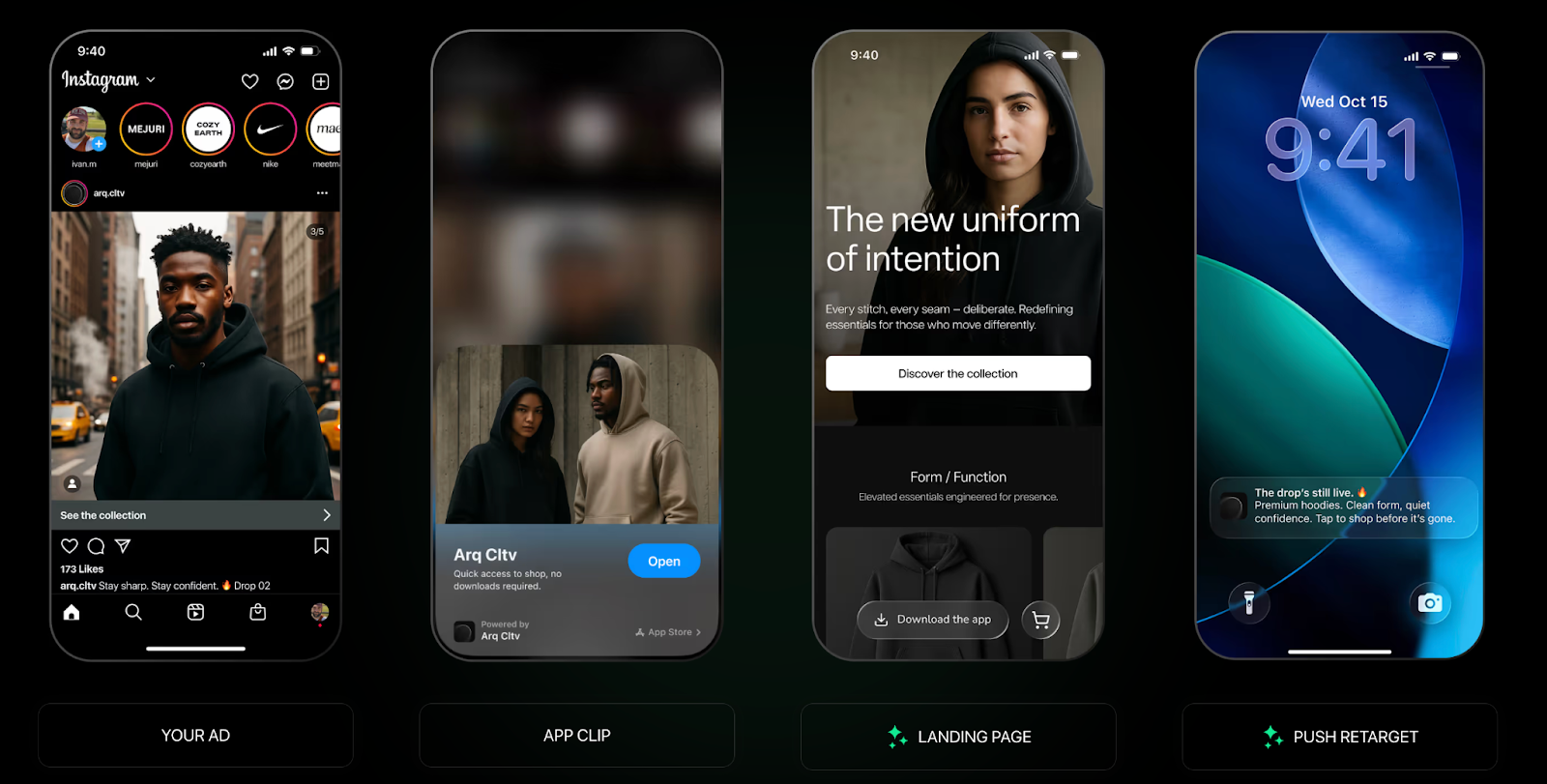
Future-proof your mobile marketing by powering SMS flows with smarter landing pages and automatic push notifications.
Do you really need to use both? (spoiler alert: yes)
It’s really not SMS versus push notifications—they’re actually better together.
Like the best superhero and sidekick combos, SMS and push notifications amplify each other. They’re a regular dynamic duo—at least in the mobile marketing world.
Using both of these mobile marketing channels helps strengthen end-to-end communication and improve your remarketing flow. They also help target separate stages of the customer journey.
It’s worth reaching out in multiple ways, too, because omnichannel campaigns with SMS are 48% more likely to convert. That’s potential you just can’t afford to miss out on.
Another way to maximize your post-click conversions? Try integrating both channels with your remarketing and retargeting flows.
Need even more inspiration? Check out these retargeting ads examples that successfully converted.
Your winning strategy in three simple steps
So, how do you start building your SMS and push notification strategy? It’s actually easier than you’d think.
Here are three simple steps to get started:
- Start with push notifications for app/web users (or users who engage with an ad clip) to maximize owned engagement.
- Use SMS for acquisition discounts, transactional order updates or to amplify new product drops.
- Trigger coordination to make sure you’re not spamming the same customer across channels.
Perfectly balanced, as all things should be: Cozy Earth’s strategy
Cozy Earth is a luxury bedding and loungewear store that has struck the perfect balance of SMS and push notification marketing.
Alongside their fully optimized ecommerce store, Cozy Earth offers a mobile app for exclusive memberships, wishlist features, and special offers.
When a new customer visits the site, they’re offered a 25% welcome discount if they opt in to SMS messages.
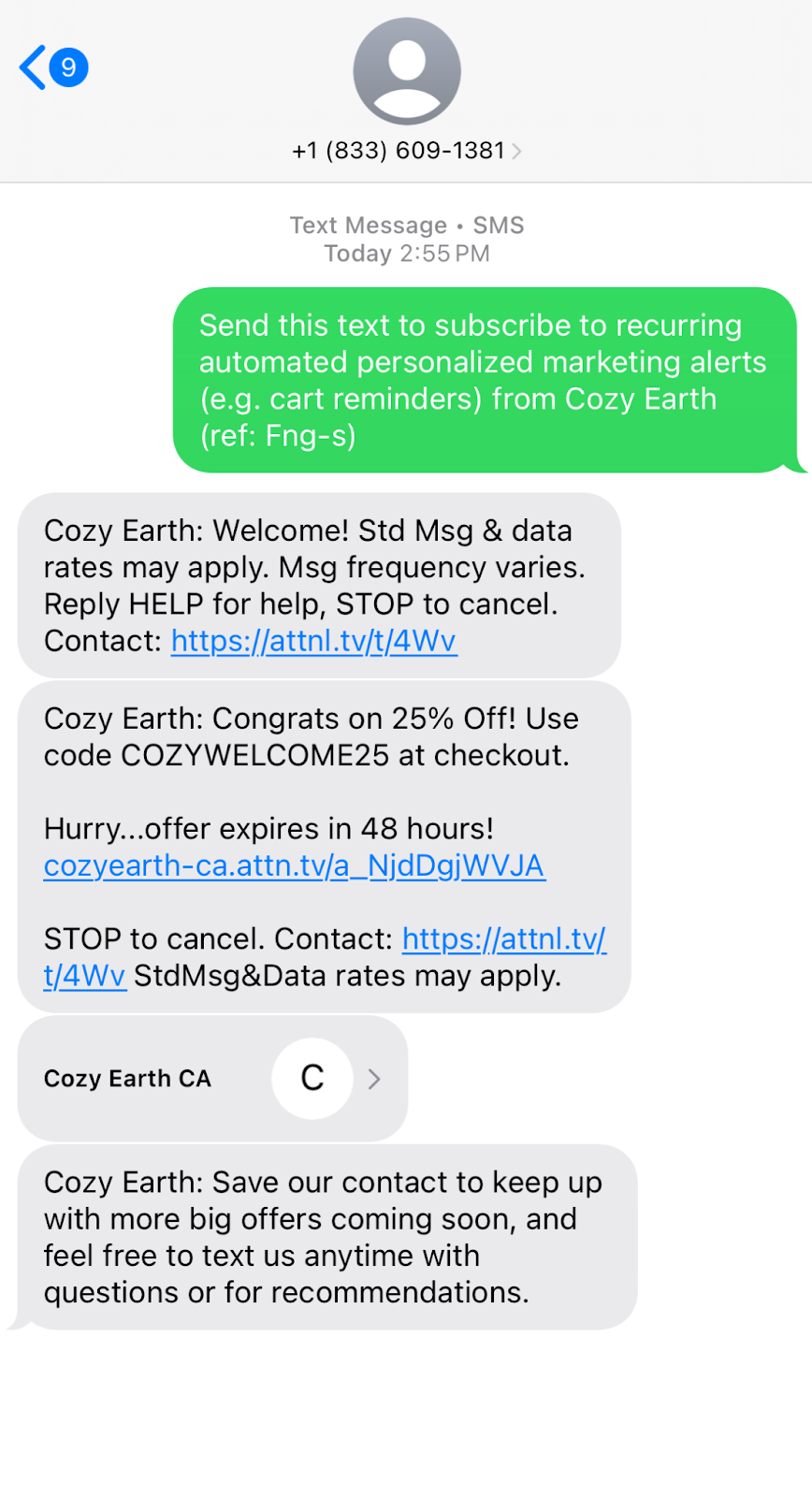
Cozy Earth also makes it easy for the customer to add them as a contact—a crucial step to avoid being filtered into the Unknown Senders folder.
Lastly, they leverage push notifications for app users or customers who click on their social ads via Reactiv Clips.
Reactiv is redefining what’s next in mobile marketing
New privacy updates have changed how brands reach customers via SMS. But like we said, this isn’t the end of SMS, just the latest iteration.
Just as marketers once learned to balance email and SMS, the next phase is about balancing SMS and push notifications. Mastering this is the key to building stronger, more adaptive communication strategies.
Remember: the question isn’t whether to use SMS marketing or push notifications. It’s how to use both in a complementary way to maximize your mobile engagement.
Reactiv is ready to help you future-proof your strategy with app-free push notifications to complement your SMS campaigns.
.png)
8 customer acquisition strategies to promote your Shopify store
Shopify is a lot like chess.
Sounds weird, right? But hear us out – both are easy to learn, hard to master, and involve a lot of moving pieces. And when it comes to strategy – the kind that makes you a chess or Shopify grandmaster – standing out from the crowd takes time, patience, and practice.
And it’s a big crowd: there are currently 2,744,406 active Shopify stores. That’s a lot. This gigantic number is why average online conversion rates are sitting around 2%.
To add salt to the ecommerce wound, acquisition is also only getting more expensive. Between Apple’s iOS privacy updates, the phaseout of third-party cookies, and tightening data laws, it’s becoming harder for brands to retarget customers through paid ads and pixel tracking.
So how do you promote your Shopify store effectively? The answer is a healthy mix of customer acquisition methods, and we’re breaking down 8 of them in this article.
Let’s dive in!
What is customer acquisition?
Let’s start with the basics: customer acquisition is the process of attracting and converting new shoppers into paying customers through a mix of organic, paid, and owned.
The key success metric to monitor is Customer Acquisition Cost (CAC) – the average amount spent to acquire a new customer. This average CAC for stores is rising year-over-year – the current average in 2025 is $70-$80 (up 40% from 2023).
Customer acquisition isn’t a one-and-done – it’s an ongoing process for you and a multi-touch, omnichannel journey for your customers. A shopper might see an Instagram ad, read a blog post, scan a QR code, and get a push notification – all before finally converting.
With this mini lesson out of the way, let’s take a look at how to advertise a Shopify store through 8 powerful customer acquisition methods.
#1 - Paid ads and retargeting
Remember how we said it’s becoming harder to attract and re-convert customers through paid ads and retargeting? It is, but that doesn’t mean you should ignore it.
Despite the limitations, paid ads are still a key part of acquiring new customers.
One big change is the way you use this strategy: with the aforementioned privacy restrictions in place, successful ad campaigns now depend on owned data and hyper-personalized messaging. Instead of casting a wide net, focus on granular targeting to reach specific segments.
Paid ads platforms to try
- Meta (Facebook/Instagram): great for social proof or product carousel ads
- Google Search & Shopping: powerful when targeting high-intent buyers ready to make a purchase
- TikTok: an impactful platform for discovery-driven audiences
Using retargeting
Setting up the campaign is only half of the strategy – retargeting is the yin to paid ads’ yang. Retargeting allows you to cash in on your messaging and convert customers who didn’t make a purchase the first time around. While 70.22% of online carts are abandoned, effective retargeting can help you recover around 26% of them.
Paid ads and retargeting in action
Good Protein is a good user of paid ads and retargeting. By pairing social ad retargeting with a welcome offer to encourage first-time purchases, they have a customer acquisition plan that comes together as deliciously as a mixture of their chocolate and peanut butter-flavoured shakes.
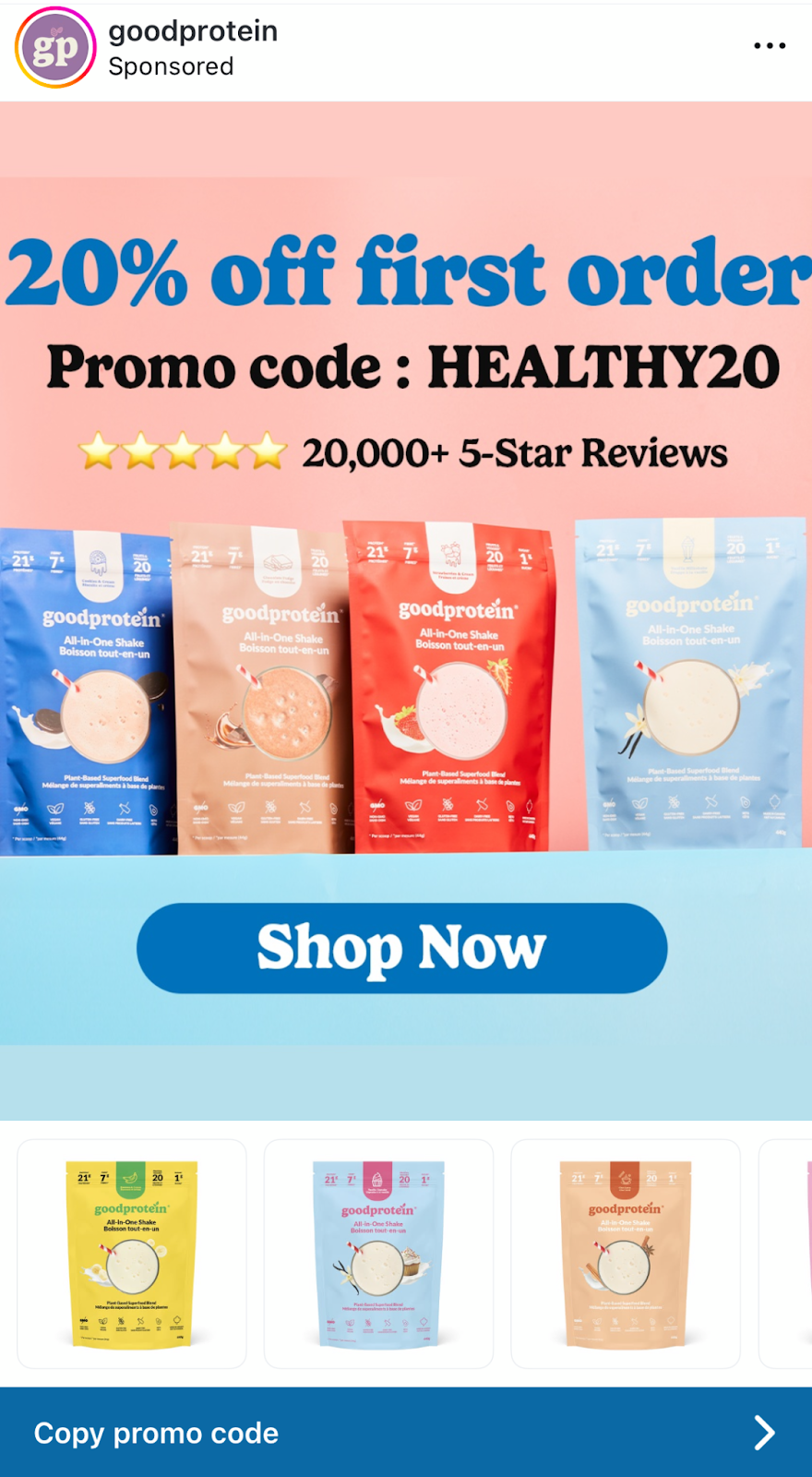
#2 - Reactiv Clips
Getting a prospective customer to download your app is a tough sell. It’s time-consuming, takes up precious storage on their device, and, honestly, it’s just kind of a whole thing. That’s why Reactiv Clips are such a powerful mobile engagement tool.
What’s a Reactiv Clip?
Reactiv Clips are lightweight versions of mobile apps. They allow users to access specific parts and features of your app without actually having to download it.
With an open rate of over 60%, Reactiv Clips are the perfect way to let potential customers experience your app without the risk of them bouncing before downloading. Plus, once someone engages, you have an 8-hour window to send personalized push notifications – no opt-in needed.
A typical Reactiv Clip user flow
Here’s a look at how a hypothetical customer (we’ll call him “Bill”) would interact with your brand using Reactiv Clips:
- Bill clicks your Instagram ad, leading him to a Reactiv Clip. Hi Bill!
- This immediately launches your product or collection landing page.
- Bill leaves the page to respond to his multitude of Instagram DMs.
- Bill is retargeted with a personalized push notification. He clicks the notification, bringing him directly to the checkout page with the product already in his cart.
- Bill places the order.
- He receives a push notification encouraging him to download the full app to track his purchase. Great work, Bill!
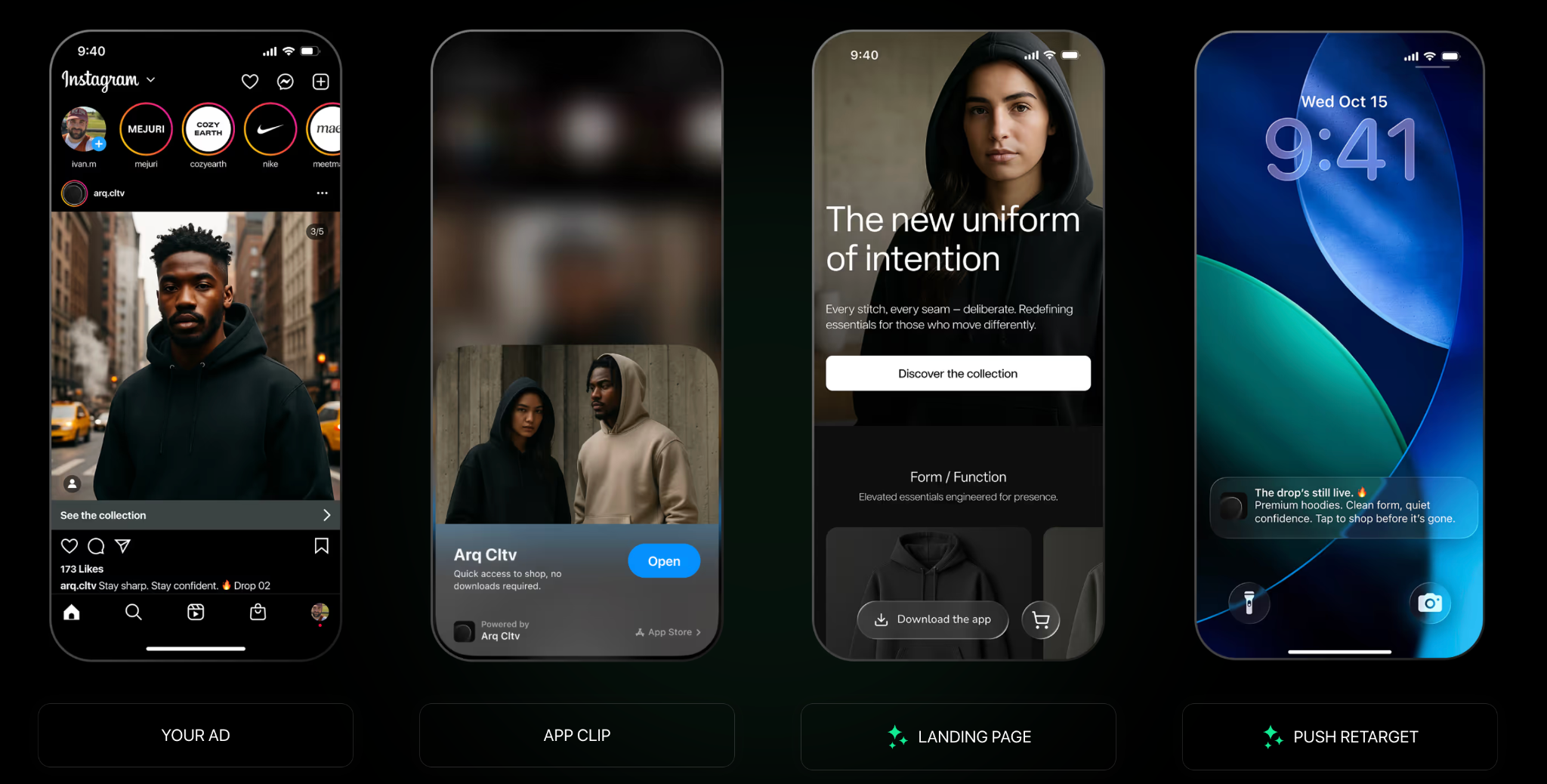
As you can see from Bill’s ecommerce adventure, Reactiv Clips take a few moves off a customer’s path to checkout, providing a streamlined experience for them and a stronger conversion flow for you. Win/win!
P.S. Social ads are just one of many ways to use Reactiv Clips in your campaign. More use cases can be found here.
#3 - Conversational commerce: Shopping via LLMs
The rise of AI chat tools like ChatGPT, Claude, and Gemini has sparked a new era of shopping called conversational commerce. Instead of scrolling through product pages or sifting through Google results, shoppers are simply asking AI to find what they want.
And it’s taking off fast: the global conversational‑commerce market is projected to grow from roughly US $8.8 billion in 2025 to about US $32.7 billion by 2035 (CAGR ~14.3 %). Ecommerce brands are clearly betting big on AI-powered shopping.
How conversational commerce impacts Shopify stores
Conversational commerce means your Shopify store can now be discovered inside AI chats – where customers are actively making purchase decisions. OpenAI has even made it possible for Shopify brands to let customers check out directly in ChatGPT, effectively consolidating the entire customer journey into one chat.
This trend combines personalization, immediacy and conversion. Shoppers get contextual recommendations, while brands gain a new channel to acquire high-intent customers.
Improving your visibility on LLMs
To appear more frequently on LLMs, optimize your product descriptions, collections and overall content for Answer Engine Optimization (AEO). AEO involves optimizing your content to be better understood, trusted and sourced by LLMs.
Strong AEO helps your store and products appear when shoppers ask intent-driven questions like “I’m gluten intolerant. Help me find a probiotic supplement to improve my gut health”.
AEO in action
Cozy Earth wraps their customers in comfort – and their content in strong AEO. When our hypothetical friend Bill asked ChatGPT for a “cooling sheet set,” it responded with helpful tips and product recommendations – including a set from Cozy Earth.
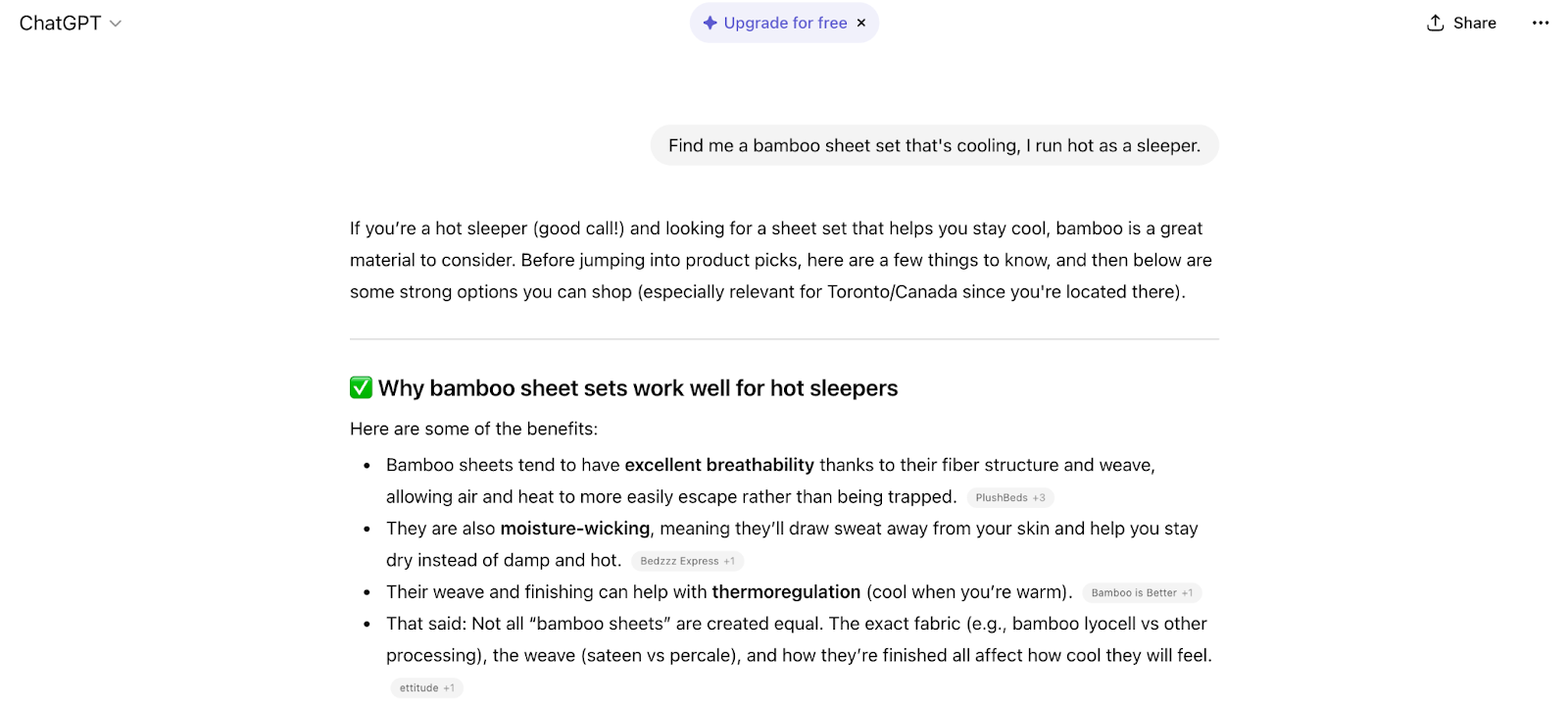
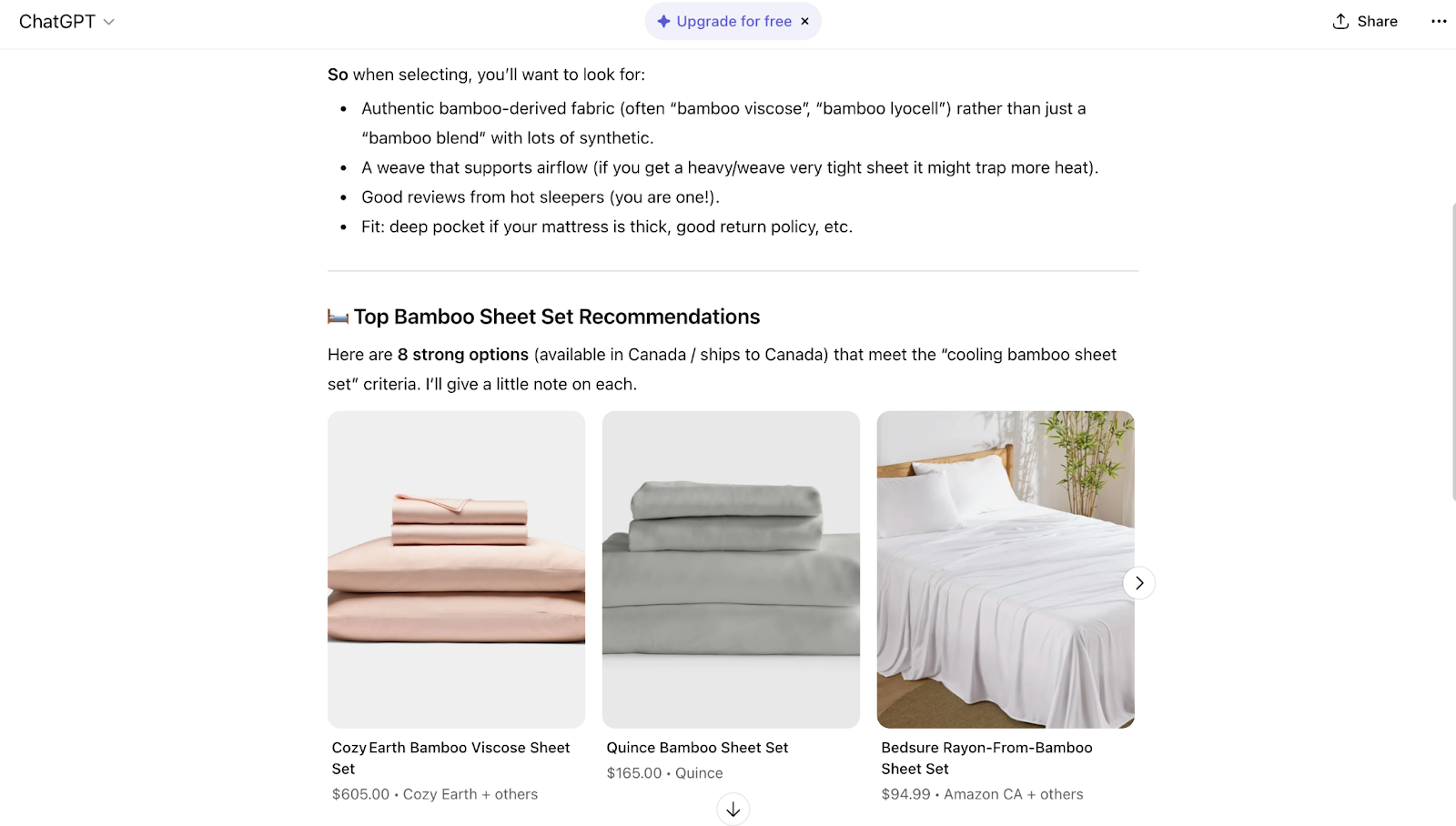
Retargeting customers via LLMs
With more and more customers getting product recommendations from LLMs, retargeting them just makes sense. Reactiv is the only platform that lets you do this. With Reactiv, you can:
- Run Reactiv Clips directly out of ChatGPT and other LLMs
- Send shoppers to a mobile app (without requiring a download!)
- Retarget them for 8 hours with push notifications
Conversational commerce is redefining the customer journey – make sure your pieces are on the board so you’re part of the game.
#4 - Email marketing
Email marketing predates the modern internet, with the first recorded instance occurring in 1978. There’s a reason it’s still around: it works.
While the first-ever marketing email was sent unsolicited by Gary Thuerk (giving him the nickname “Father of Spam”), today’s email marketing couldn’t be more different.
Powered by owned, zero-party data, customers are now choosing to hear from you by actively showing interest in your brand. This powerful (and profitable - the average ROI per $1 spent is $36 - $40) intent makes them the perfect candidate for future outreach.
Building your email list
If you don’t already have an email list, it’s never too late to start:
- Before opening your store, create a pre-launch page: You’ll have to pair this with another strategy to get the word out, but having a list of interested customers before you start selling gives you zero-party data from day zero.
- Add opt-in forms across your site: Make signing up worthwhile by offering perks like early access to new releases, exclusive discounts or product tutorials.
- Run giveaways: Incentivize sign-ups by offering a simple reward or contest entry. It’s a quick, time-tested way to grow your list.
Remarketing with re-engagement flows
Once a customer creates an account with your store, email becomes a powerful re-engagement tool. Remarket them with re-engagement flows like:
- Welcome sequences for first-time visitors
- Abandoned cart triggers
- Running promotional or holiday-specific campaigns
Email marketing in action
Indigo is one of Canada’s favourite bookstores and one of our favourite users of email retargeting. When customers browse a book but don’t purchase, Indigo sends a “Take a second peek” email that’s supplemented with additional books from the customer’s wishlist. This strategy is personal, timely, and a powerful way to encourage customers to take another look.
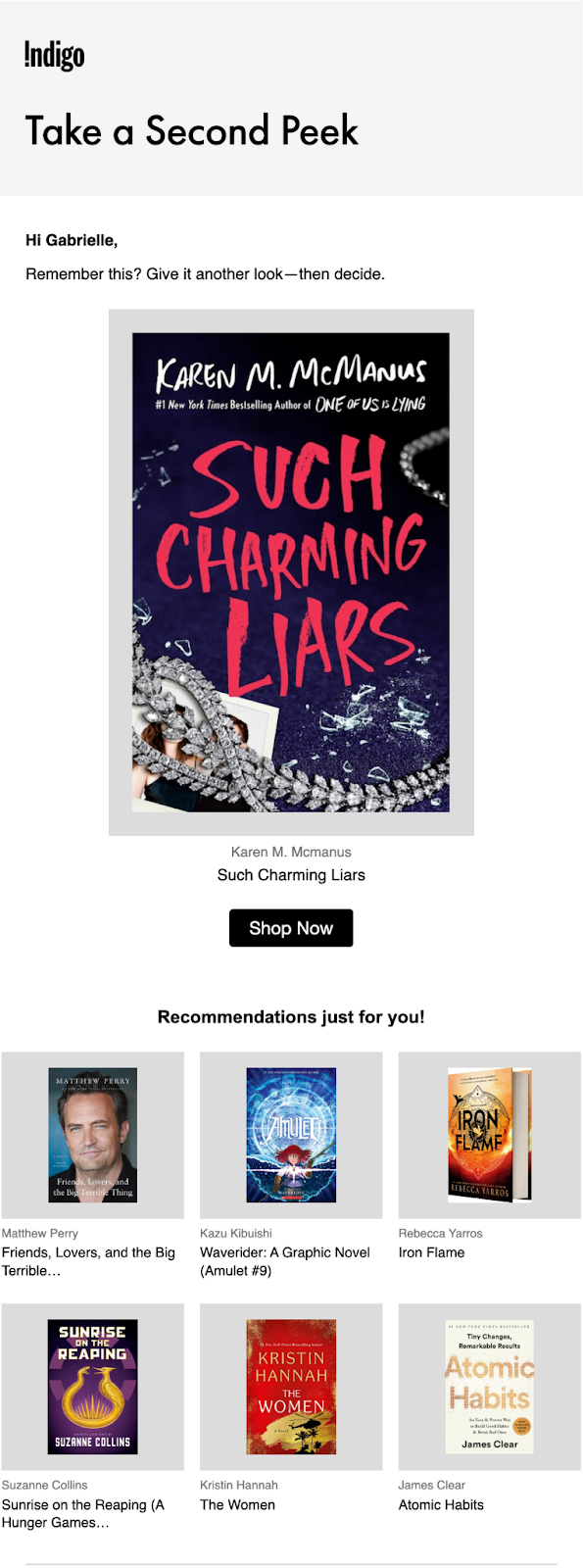
With email marketing, it’s all about the setup. Start building your list and strategy early, and you’ll keep reaping the rewards.
#5 - Organic content marketing
While it’s easy to get distracted by flashy new options, organic content remains one of the best strategies to market your Shopify store, especially when you’re just getting started.
Why? It’s free.
Free is good… And practical.
Organic content lets you test your messaging, drive discovery, and build an engaged community before investing in paid ads. Over time, present-day community members can become profitable future customers.
Organic content marketing formats
Organic content comes in many formats – mix and match to see what resonates most with different segments:
- Blog posts
- Product tutorials and guides
- YouTube videos
- Social media content
- FAQs
- And more – you’re only limited by your imagination!
Once you create content in one format, repurpose it across others. For example, a cosmetics brand could turn its YouTube tutorial for its new eyeshadow palette into a TikTok video, an Instagram carousel, a blog post, and an infographic. One great idea, multiple different channels!
SEO and AEO for organic content
Organic content is also a powerful tool for showing up in both search engines and LLMs.
Use search engine optimization (SEO) and AEO best practices across your site – including blogs, product descriptions, and tutorials – to improve visibility and organic discovery.
Let’s say you’re a skincare brand writing a holiday product guide – you’d want to include searchable queries like “best winter skincare routine” (you can find these using SEO keyword research tools). This will help you appear in both Google results and AI-driven discovery experiences.
Content marketing in action
Missouri Star Quilt Company is a star in SEO and AEO content marketing.
Beyond their shop, their site features hundreds of quilting tutorials, blogs, and templates to attract new and experienced crafting enthusiasts – all rich with keywords.
They also worked with Reactiv to prioritize the in-app tutorial experience through searchable content linked to products and patterns. In less than 2 weeks, they were able to attract 50,000 new app users. That’s a lot of stitches and a lot of app users!
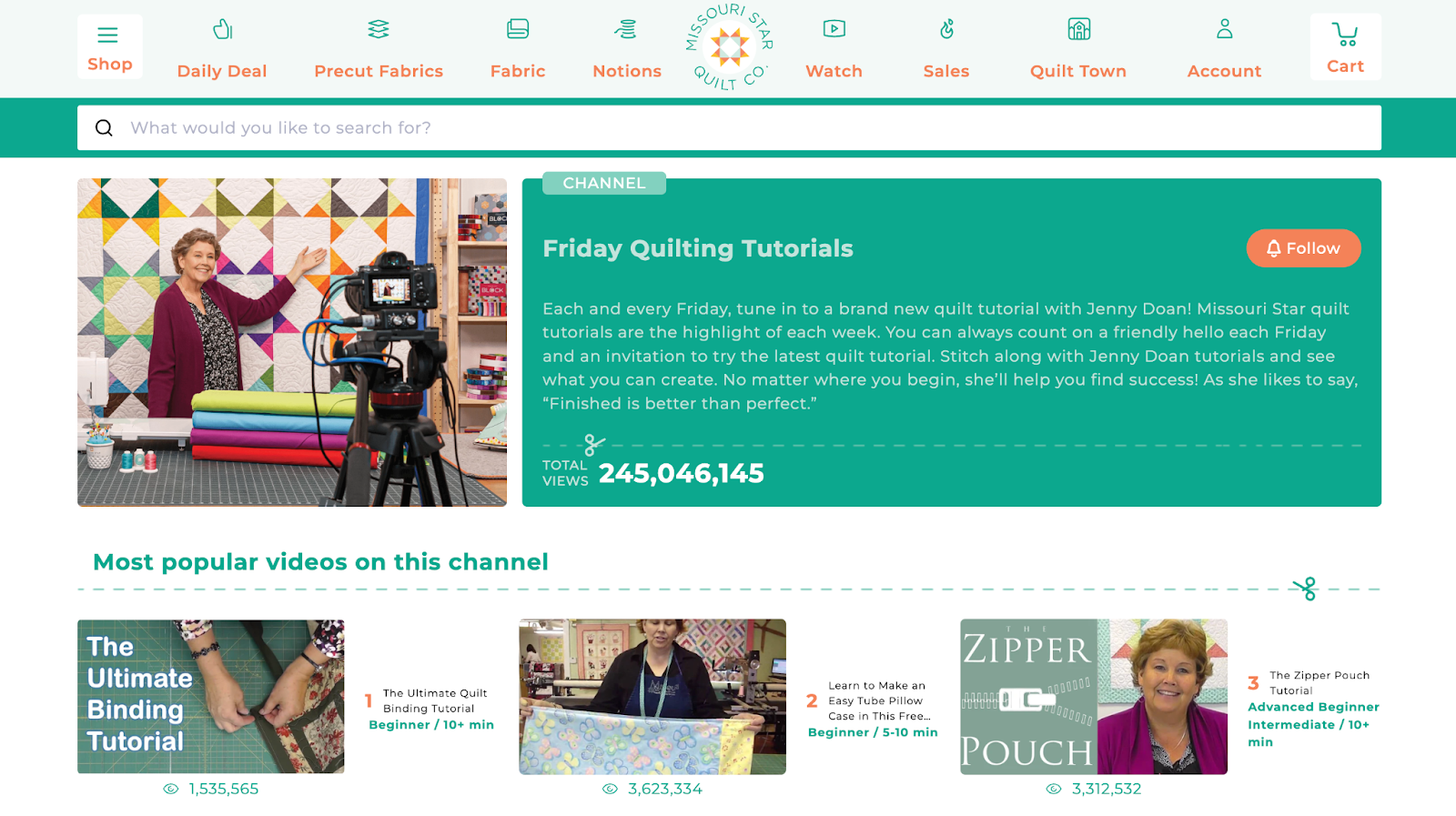

Organic content might take longer to see results, but it builds an essential foundation for your brand. Once it clicks, your board will be set for long-term success.
#6 - Geolocation-triggered tactics
For years, ecommerce and retail have been treated like opposing forces. But shoppers never saw a difference. They move seamlessly between stores, mobile, and desktop, expecting every interaction to feel like part of one brand experience.
As of 2025, 73% of retail consumers identify as omnichannel shoppers: browsing online, researching on mobile, and buying in person. Yet most acquisition strategies are still built in silos. It’s time to bridge both worlds.
With Reactiv Clips, brands can bridge that gap effortlessly.
Using geolocation triggers, NFC taps, or QR codes, Shopify brands can create fluid, real-world moments that convert on the spot and feed right back into their digital ecosystem.
Picture this:
- A shopper walking past your store gets a Siri prompt to explore your latest collection.
- Fans at a stadium can buy a jersey instantly from their phone without having to download anything.
- A nearby coffee lover gets a notification to order ahead from your café and skip the line.

Once a shopper interacts with one of these Reactiv Clip experiences, brands can send push notifications and personalized updates that strengthen the relationship long after that first scan or tap.
Here are some creative ways you can leverage this:
1. Turning every store shelf into an interactive experience
QR codes on shelves or product tags can instantly unlock:
- sizing guides
- ingredient details
- UGC
- care instructions
- customer reviews
- stock availability (especially for variants not displayed on the floor)
Customers can pull up this information on their phones instantly.
2. Converting retail visitors into digital subscribers
Clips let shoppers opt into:
- loyalty programs
- product launch notifications
- restock alerts
- limited-time in-store offers
…right from the aisle they’re standing in. (Or seat they’re sitting in, like how we built this experience for a basketball game at Madison Square Garden.)
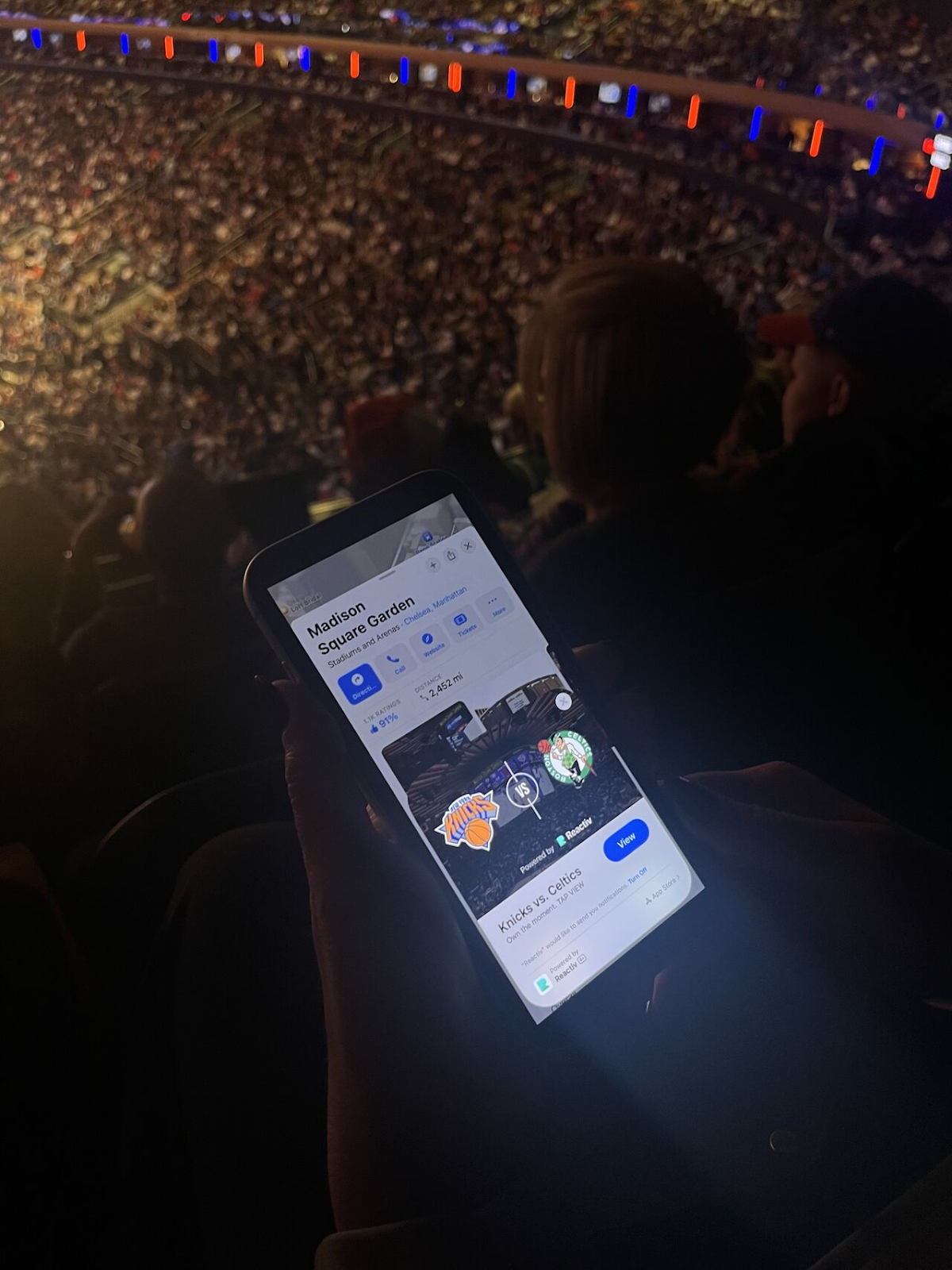

3. Recovering missed sales in-store
If a location is out of a product or a size, Clips can automatically open a pre-filled cart for:
- ship-to-home
- same-day courier
- pickup at the next-nearest store
It removes the “we’re out” friction and saves an otherwise lost sale.
4. Turning staff into storytellers, not cashiers
Reactiv Clips give store associates tools they can pull up instantly to:
- demo complex products
- share comparison charts
- guide purchases
- trigger add-ons or bundles
- text a Clip to the customer for later
This turns retail into a high-conversion consultative experience.
#7 - Influencer marketing and partnerships
If you’ve been on any form of social media or video platform in the last decade, you’ve encountered influencers.
And for good reason: influencer marketing has become a staple in many acquisition strategies because it gives you access to one of the most effective ways to reach new audiences – leveraging someone else’s.
Finding the right influencer
By working with an influencer, you’re able to tap into the trust and engagement a creator has already built with their audience.
This makes choosing the right influencer incredibly important – you need to ensure you’re reaching your ideal customers and that your message comes across as authentic. As tempting as it may be, partnering with the right micro-influencer is often a lot more powerful than splurging on Kim Kardashian.
Play your cards right, and you can see incredible success: 31% of social media users say they prefer discovering new products through influencers they follow over any other format or channel. For Gen Z, this climbs to 43%!
Influencer strategies to drive acquisition
There are endless ways to work with influencers to drive acquisition, such as:
- Using personalized discount codes or affiliate links to track engagement and measure ROI
- Collaborating on unboxings, tutorials or TikToks that drive directly to your Shopify store
- Use Reactiv Clips to sponsor influencer posts from your store’s social accounts to driving users directly to an app-like experience
Influencer marketing in action
Mejuri may be a fine jewelry brand, but their influencer marketing is more than fine.
Fine jewelry – especially online – is a hyper-competitive market, so Mejuri leverages a wide network of creators and influencers to break through the noise.
Just take a look at their #MejuriPartner hashtag, and you’ll find thousands of posts with hauls, unboxing videos, jewelry tours, and more.


When you find the right creators to partner with, it’s not about spending money on the biggest star you can find – it’s about making the right moves to set you up for success later in the game.
#8 - Loyalty and referral programs
It makes sense that a referral program is a strong acquisition strategy that doesn’t break the bank – but you might be surprised to learn loyalty programs are, too.
In fact, they’re more than strong: 79% of customers say they’re willing to create a store account in exchange for loyalty points.
Once you have their data, you can add them to segments and re-engage via email, SMS, and other channels to secure that first purchase. Loyalty programs are also an excellent incentive for app downloads – pair them with exclusive app-only offers, bonus points, or personalized content to drive app engagement.
With a referral program, you can leverage the loyal customers you already have to do your marketing for you.
Strategies and tactics for loyalty and referral programs
There are plenty of great Shopify app options to build your loyalty and referral programs in minutes, including:
Once you have your foundation in place, use these tactics to get started:
- Add referral code prompting post-purchase emails and order confirmation pages.
- Incentivize social shares and repeat purchases with loyalty points.
- Understand and track key referral metrics such as the number of referrers, referred new customers, cost per referral, and the retention rate of referred shoppers.
Loyalty and referral programs in action
Obvi obvi-ously knows what they’re doing when it comes to loyalty and referral programs. Not only do they offer a robust rewards program with multiple ways to earn points, but their referral program also benefits both sides: referrers and new customers each receive a $15 discount on their next purchase. That’s one healthy discount!
Sticking with our chess analogy, every customer is another piece on the board – the right loyalty and referral programs let you set them up to play the long game.
Promote your Shopify stores wherever your customers are
People aren’t monolithic. There’s no magic “one size fits all” approach to customer acquisition, even with the most niche target audience.
With omnichannel shopping more common than ever and customers receiving messages on every possible platform, it’s important to capture customers across multiple touchpoints with a strong multichannel strategy. The best way to tie it all together? Reactiv Clips.
Pairing Reactiv with these customer acquisition strategy examples, like influencer campaigns, paid ads, email, SMS, and geolocation-triggered tactics, will ensure you stay top of mind and can re-engage customers wherever they are.
Interested? Talk to our team today and start turning your acquisition strategy into a winning board.

Mobile Apps Need SEO Too. Here’s What You’re Missing
In an increasingly crowded app ecosystem, standing out takes more than just a good product. And with search engines indexing more app content than ever, Mobile App SEO is no longer optional.
Where to start? Right here, your crash course in boosting mobile app visibility.
App Store Optimization (ASO): What is it and why should you care?
When discussing app store optimization (ASO), we’re talking about the process of improving your app’s visibility and ranking in app stores like Google Play and Apple App Store. Think of it as mobile app SEO—like SEO for websites, but designed specifically for app stores.
And this is why you want to know this: In 2025, app stores are the top channel for app discovery. Apple’s June 2025 App Transparency Report showed that over 50% of app downloads come from organic search within the app store. Without ASO, even the best apps stay invisible.
Just like your website—or any marketing channel for that matter—great content isn’t enough anymore. It’s all about distributing your content and helping customers discover you. And with ASO, you’ll see the benefits take the form of:
- More organic downloads. Which means more potential customers to retarget
- Lower customer acquisition costs. You can scale back ad spend
- Stronger brand presence. Especially where it counts like on your digital channels
- Higher retention. The app reaches users who are actually looking for what your app offers, leading to improvements in your mobile CRO
Want to know more about mobile CRO? Read more here.
ASO factors you can control to climb the ranks
Alright, now we know why ASO matters. On to the more important part—how does it actually work?
While there is always some mysterious, black-box element to algorithms, there are several elements you can control to improve your app’s ranking in various app stores. Here are some tactics to be aware of:
- App name and subtitles. Keep it descriptive and brief
- Icons. Typically, your store logo
- Ratings and reviews. Social proof from other customers
- App preview and screenshots. Give users a taste of what they can expect once they download
- App description. Explain what users can find in the app (i.e. loyalty programs, exclusive discounts, memberships, etc…)
App updates. Shows users that you’re actively investing in the UX

7 steps to improve your app store optimization
To rank higher in the app store, here seven considerations you can’t ignore:
1. Nail your keyword and user intent research
ASO starts with understanding your relevance. Why? Because sometimes you don’t know what you’re looking for until you find it. The same is true in the app store.
According to AppTweak, 65% of all App Store downloads are triggered by searches of generic terms, meaning keyword optimization is vital. Here is are ways to go about this:
- Utilize keyword research tools. Find those specifically designed for app stores like AppTweak, Sensor Tower, and App Radar. Discover high-volume, relevant keywords.
- Prioritize highly targeted keywords.In the age of Chat-GPT, the way users search is changing. That’s why prioritizing long-tail, intent-based keywords is a great way to attract meaningful traffic that is more likely to convert. For instance, you may want to rank for “waterproof dainty gold jewelry” instead of “gold jewelry” to attract the right shoppers.
- Continuously refresh your keywords. Things change quickly. Because of that, it’s best practice to update your keywords on an ongoing basis. App Radar recommends updating your ASO strategies every 1-2 months (6-8 weeks for Google Play Store and every 4 weeks for Apple App Store
- Quality over quantity. More keywords does not equal better rankings. This veers into spammy, keyword stuffing, which not only makes for a poor experience but also hurts your ranking in the algorithm.
2. Optimize metadata (title, subtitle, & description)
Metadata is a major ranking lever. In 2025, ASO experts emphasize that metadata—especially titles and subtitles—remain the primary way app stores assess relevance.
Metadata is one of the most important places to apply that keyword research you did. Include top-performing keywords in your title:
- Apple App Store. You get 30 characters for your title and another 30 for your subtitle. Make them both count by using various keywords.
- Example. Add your primary keyword next to your brand name in the title and focus your subtitle on your main benefit, with a secondary keyword
3. Boost visual appeal & storytelling in your listing
Visual elements dramatically affect conversion. For example, think of all the places your app’s icon appears: app store listings, users’ home screens, phone settings, and more. It’s your visual identity so it needs to represent your brand and mobile experience effectively.
Recent studies indicate that optimizing your app's visual assets, like user ratings, screenshots, and videos, affects conversions, not just rankings. Here are ways you can do this:
- Stay on brand. Ensure your app icon is visually compelling and on-brand.
- Use high-quality screenshots. Use screenshots that showcase your app's core features and benefits (for instance, product collections, checkout pages, community forums, member-only offers, and more).
- Test your screenshots. Both Google and Apple let you A/B test screenshots. For example, create cohesiveness with your screenshots to tell your brand narrative, visually.

Something to note: Apps with a preview video see a 20% to 40% higher conversion rate than those with screenshots alone. Including a short, engaging preview video can provide users with a clear understanding of your app's functionality and user experience.
4. Prioritize ratings and review management
Bottom line: your app store reviews could be the make-or-break factor on whether someone downloads or bounces.
Research shows that 50% of mobile app users won’t download an app with a 3-star rating. That climbs to 85% when it’s a 2-star rating. And we’re not just talking about a few users—77% of mobile app users read at least one review before downloading a free or paid app.
While you can’t directly impact your reviews and ratings, there are strategies to encourage your app users to help you influence this factor:
- Prompt feedback. Encourage feedback from consumers post positive interactions.
- Respond to reviews. Showing gratitude and resolution matter and signal to other potential customers that you care about your community’s feedback

- Monitor sentiment trends. Use recurring themes to improve the product, listing, description, or UX.
5. Boost retention and engagement signals
Getting users to convert and download your app is step one. But in 2025, app stores reward apps that keep users active.
Higher retention signals to Apple and Google that your app provides value, improving ranking. On average, only 21% of users return to an app within the first 24 hours, dropping to 7.5% by day 10 and just 1.89% by day 90.
What this means is that if you can keep users to return (even just on day two), you’re already ahead of the competition. Here is how you can get users to come back:
- Make it easy. Simplify onboarding flows to reduce drop-offs.
- Make it personal. Use personalized push notifications to re-engage lapsed users.
- Make it trackable. Track key retention metrics (Day 1, Day 7, Day 30) to assess performance
- Make it desirable. Employ loyalty or gamified features to keep users returning

6. Localize to go global
If you ship to international markets, your app should reflect that. And localizing your app can help you break into new markets. Industry knowledge shows that 80% of top-grossing app markets speak languages other than English.
And studies show that apps that localize metadata and visuals see up to 128% more downloads in targeted countries. You can take advantage of this, here’s how:
- Translations. Translate app titles, subtitles, and descriptions into target languages or spellings. For example, UK English/Canadian English vs. US English. Or term differences based on local slang.
- Visual adaptations. Adjust visual elements (screenshots, videos) for cultural resonance
- Localize keywords. Optimize keywords per locale using localized keyword research tools.
7. Continuously test, iterate & monitor ASO performance
Algorithms, user search behavior, and app store ranking factors are constantly changing, especially in the age of AI. A winning ASO strategy is not a set it and forget it one—when technology changes so should your ASO.
Stay dynamic to continuously adapt to an ever-changing landscape:
- Google Play testing. Use Google Play’s built-in A/B testing and replicate via segmented testing on iOS
- Track performance. Track metrics like keyword and category rankings, install conversions, and retention week over week
- Stay in the loop. Adapt to new app store features—like Apple’s Custom Product Pages (CPPs) with deep linking, and Google Play’s Custom Store Listings (CSLs)—to boost targeting and conversions
- Consistently refresh. Seasonally update your approach to align with holidays, trends, or cultural moments.
Boost your app rankings with Reactiv
Remember: app store optimization drives installs—but ranking isn’t enough if users churn quickly.
By using Reactiv, you can improve your ASO while minimizing churn by:
- Engaging users instantly via Reactiv Clips (boosting retention signals that stores reward).
- Personalizing onboarding and push notifications (i.e., asking for app store reviews a couple of days after downloads, and sending push notifications with personalized offers for dormant customers)
- Running A/B tests on landing pages and campaigns that directly support ASO
Now that you know about us, we want to know more about your business. Book a Reactiv Clips demo today.
Built to adapt at every stage
We’re here to power your mobile success now and in the future
See Reactiv in Action